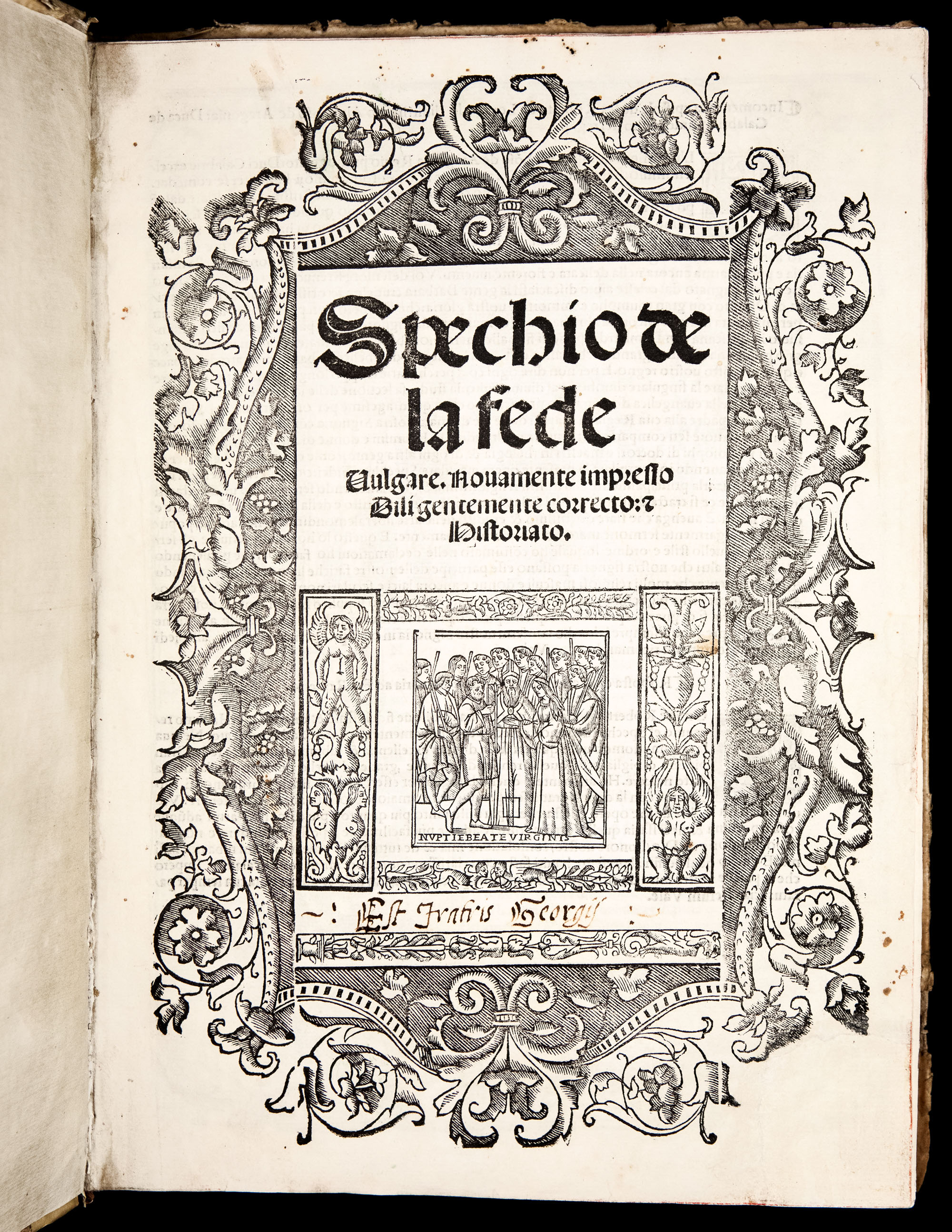
SOLD ($2,900)
Printed in Venice by Piero de Quarengi, 1517.
Text in Italian. Illustrated with over forty fine woodcuts.
This is a fine, richly illustrated post-incunable Venetian edition of the popular vernacular collection of 45 sermons by the famous Franciscan preacher Roberto Caracciolo da Lecce (c.1425-1495), Bishop of Aquino, and of Lecce, who was renowned as the most celebrated Italian preacher of his time. Called by his contemporaries the "Second Paul", and the "Prince of Preachers", he was able to arouse his listeners to sometimes unseemly levels of emotion, and partly for that reason, he was a somewhat controversial figure among the Franciscans of his time. Caracciolo was one of the first Italian authors to see his works appear and disseminate in print during his lifetime, and, in fact, become best-sellers! Beside the biblical and patristic sources Caracciolo mentions (and occasionally quotes) ancient "pagan" philosophers and writers such as Aristotle, Plato, Socrates, Xenophon, Strabo, Apuleius, etc.
Roberto is considered “one of the most popular preachers of the so-called ‘second wave’ of fifteenth century Franciscan preachers, who followed in the wake of Bernardino da Siena.Roberto was educated by the Conventual Franciscans, professed vows with the early Observants (a reform movement), and returned to the Conventuals in 1452, staying with them until his death in 1495. He was known for preaching in the style of Bernardino da Siena. […] Several collections of Roberto da Lecce's sermons have been edited and published, including the Latin series from the Lent of 1455 in Padua (Quaresimale Padovano), the vernacular sermons he preached in Venice in 1474 (Quaresimale in volgare), and his collection of sermons entitled Specchio della fede (1495). Roberto da Lecce treated many aspects of Christian life (e.g., sin, vices and virtues, conversion, the grace of God, the sacraments, and the last judgment). […] Roberto spoke not only on Christian themes to his Christian audience, but also preached against Jews and other unbelievers, and corrupt and worldly Christians who were perceived to be threatening not only Italy but all of Christendom. Since the major external threat to Christendom were the Ottoman Turks, Roberto dedicated [several] sermons on Muhammad and Islam, one [of them] in Italian in the ‘primo mistero’ section of the 'Specchio della fede'.” (Timothy Johnson, Franciscans and Preaching, p.327-8)
The present collection first appeared in 1495 and was printed again in 1505; all editions of the work are very rare.
Bibliographic references:
Adams C-623; Essling 836; Sander 1709.
Physical description:
Folio, texblock measures 29.5 cm x 20.5 cm. Bound in 16th- or 17th-century vellum-covered boards, overlaid with earlier Hebrew manuscript leaves. Edges dyed red.
Foliation: 155 leaves, numbered in roman numerals (forming 310 leaves).
COMPLETE.
Title printed in large gothic type, over a fine woodcut of The Marriage of the Virgin (with a legend ‘Nuptie beate virginis’), all within a fine ornamental woodcut border of foliage and flowers. The opening page of the text (A2) with a superb large woodcut of Caracciolo preaching to a large crowd in a town square, and enclosed within an elaborate woodcut border of foliage, cornucopia, armor, putti and sirens blowing trumpets, etc., with God in an arched compartment at the top. Further illustrated with over 40 superb woodcuts in text, snd numerous woodcut initials.
Includes (on verso of title) Roberto’s dedicatory epistle to Alfonso V of Aragon, king of Sicily and Naples, and Alfonso’s response. Also includes a table of contents (Tabula).
Colophon and Register on verso of the final leaf.
Provenance:
A 16th-century monastic ownership inscription “Est Fratris Georgii” at bottom of the title-page.
Condition:
Very Good antiquarian condition. Complete. Binding rubbed, with some soiling, staining, scratches or superficial cuts; edge-wear (particularly to corners), but binding solid, with boards firmly attached. Internally with occasional light soiling (mostly marginal), snd a few minor ink-smudges. A few leaves with small marginal notes or ‘pointing hands’ in ink, in a 16th-century hand. A few leaves in quires O-P with small (and harmless) marginal scorch-mark at the bottom edge (far from printed area, which is completely unaffected). Final leaf with a minor repair at the bottom, affecting a few words in the table of contents only. In all, a very nice, genuine example of this beautifully illustrated vernacular post-incunabulum.


















